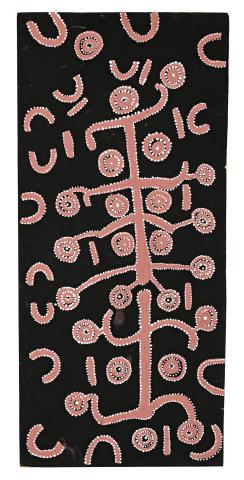WILD POTATO STORY, 1971
CHARLIE WARTUMA (TARAWA) TJUNGURRAYI
synthetic polymer powder paint and synthetic binder on plywood
88.0 x 41.0 cm
inscribed verso: artist's name 'Charlie JUNGARI' (sic), language group 'PINTABI' (sic), title and diagrammatic annotations, in Geoffrey Bardon's hand, and numbered '10'
Executed at Papunya in September/October 1971
Mr Ron Collins (editor of Geoffrey Bardon's first film on the Pintupi The Richer Hours completed in 1971)
Private collection, Queensland
Sotheby's, Melbourne, 24 July 2007, lot 41
Private collection, Melbourne
Tjukurrtjanu: Origins of Western Desert Art, National Gallery of Victoria, Melbourne, 30 September 2011 – 12 February 2012; Musée du quai Branly, Paris, 9 October 2012 – 20 January 2013 (label attached verso)
Bardon, G., Papunya Tula: Art of the Western Desert, McPhee Gribble, Penguin, Melbourne, 1991, p. 80 (illus., as 'Yam Dreaming')
Bardon, G., and Bardon, J., Papunya: A Place Made After the Story – The Beginnings of the Western Desert Painting Movement, The Miegunyah Press, Melbourne, 2004, painting 268, p. 326 (illus., as 'Yam Dreaming (Version 2)')
Ryan, J., and Batty, P., Tjukurrtjanu: Origins of Western Desert Art, National Gallery of Victoria, Melbourne, 2011, pp. 24, 303, illus. p. 216
In his publication Papunya Tula: Art of the Western Desert, Geoffrey Bardon recounts how 'the vital dancing shapes of the yam plant was first painted on a linoleum floor tile by Charlie Wartuma at Papunya in 1971 using red paint tinter'.1 Bardon found the quality of this work poor so he asked Wartuma to paint another version with better quality materials. Executed in late 1971, Wild Potato Story is the result.
Depicting the seeds, roots and fruit of the yam plant and surrounded by men in ceremonial dress holding their spears and digging sticks, Wild Potato Story is a dedication to the yam plant, a vital food source which reliably emerges out of the arid terrain to nourish desert people and an important totem in traditional culture.
A fluid and dynamic painting, the work is painted in the artist's distinctive silhouette style with the sinuous and flowing yam plant painted in red ochre and outlined with white dotting allowing the plant to seemingly hover above the black ground.
Charlie Wartuma Tjungurrayi was one of the founding artists at Papunya in 1971, an important man in traditional ceremony, and according to Dick Kimber'a naturally good teacher'.2 Wartuma developed a particularly strong friendship with the late Andrew Crocker, manager of Papunya Tula between 1980 and 1981, with whom he travelled to England and Hong Kong in 1982. Crocker subsequently organised a major retrospective of the artist's work, Charlie Tjaruru Tjungurrayi: A Retrospective 1970-1986, which toured four Australian states in 1987.
1. Bardon, G., Papunya Tula: Art of the Western Desert, McPhee Gribble, Penguin, Melbourne, 1991, p. 80
2. Kimber, R.G. (Dick), in Ryan, J., and Batty, P., Tjukurrtjanu: Origins of Western Desert Art, National Gallery of Victoria, Melbourne, 2011, p. 211
CRISPIN GUTTERIDGE
